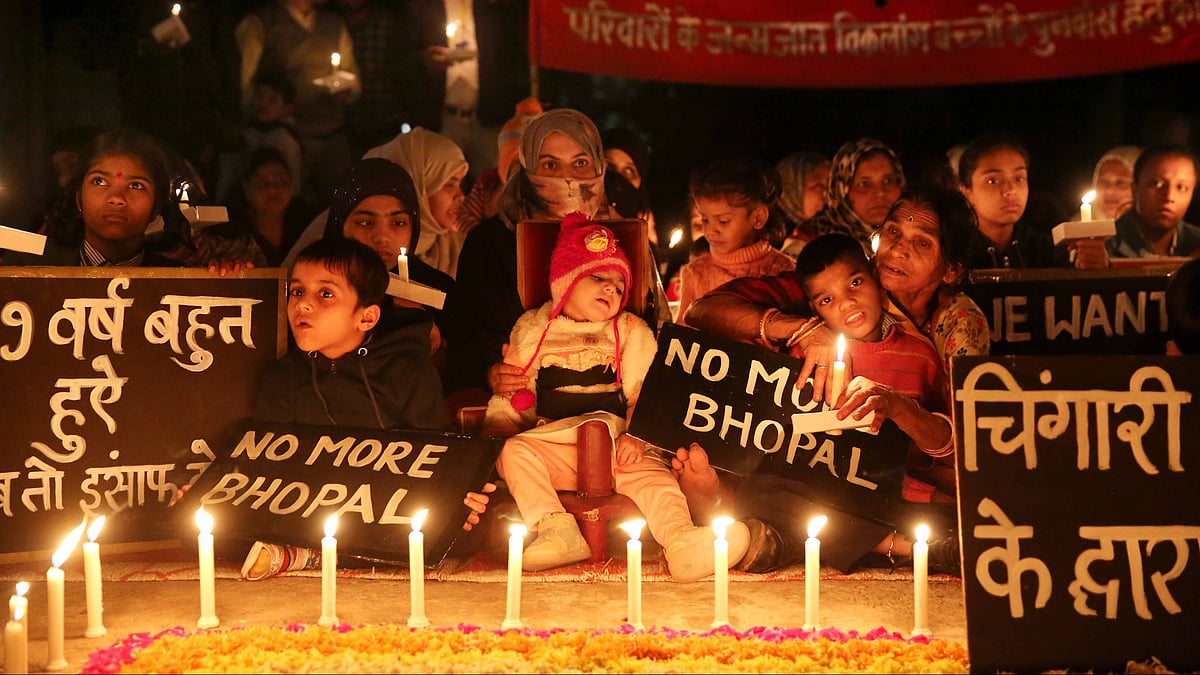Bhopal Gas Tragedy: 40 Years on, Justice Eludes Generations of Victims
About ten years after the gas tragedy, in 1994, even the ICMR suspended its research projects on the victims.

advertisement
16-year-old Turhar Hasan struggles with toys at the Chingari Rehabilitation Centre in Bhopal, Madhya Pradesh. He belongs to the third generation of a family of victims. 40 years ago, his grandparents were exposed to methyl isocyanate (MIC) used in the production of the pesticide Sevin at the Union Carbide India Limited (UCIL) factory in Bhopal.
Turhar suffers from development delay (DD), which refers to the inability of a child to gain the expected developmental skills compared to others of the same age. Delays may occur in motor function, speech and language, cognitive and play functions, and social skills.
At the same centre, there is seven-and-half-year-old Advait Bansal, who suffers from Down syndrome. Like Turhar, Advait’s mother, father, and grandparents were exposed to the gas leak from the UCIL plant on the intervening night of 2 and 3 December 1984.
Sixteen-year-old Turhar Hasan.
(Photo: Author)
Seven-year-old Advait Bansal.
(Photo: Author)
A survivors’ organisation alleged that the Indian Council for Medical Research (ICMR) "suppressed" the data on birth defects in babies of gas-exposed mothers.
Rachna Dhingra of the Bhopal Group for Information and Action told The Quint that the RTI documents obtained from the National Institute for Research on Environmental Health (NIREH) in 2019 show that its parent organisation, the ICMR, decided to not publish the results of a study that found birth defects in babies of gas exposed mothers to be several times higher compared to those of non-exposed mothers.
“The study was carried out from January 2016 to June 2017 after getting approved by three successive meetings of the Scientific Advisory Committee (SAC) from December 2014 to January 2017. But it was never made public,” Dhingra asserted.
Chingari is a non-profit organisation set up in 2006, run by two gas survivors named Rashida Bi and Champa Devi Shukla, who are recipients of the prestigious Goldman Environmental Prize in 2004. This organisation provides restorative therapies and special education to children born with disabilities as a consequence of their parents' or grandparents' exposure to the chemicals in 1984.
There are two things common in most of the children registered at Chingari: they belong to the families of gas victims and live in the localities of Bhopal that were identified as “gas affected”, Rashida explained. All of them belong to the third generation of victims. Children belonging to the second generation with different congenital health issues are also registered here.
One of the tasks of the Centre was to study psychiatric issues experienced by the victims and design a manual on how to treat them. But the Centre did not have enough expertise and lacked the resources for serious research assignments, another former employee told The Quint.
After prolonged litigation for no less than fourteen years, the Supreme Court issued some major directions on 9 August 2012, "We direct the ICMR as well as NIREH to ensure that the research work is carried on with exactitude and expeditiousness and further to ensure disbursement of its complete benefit to the gas victims."
During a hearing on 12 November 2024 at the Jabalpur High Court, when the petitioners, including Dhingra, raised the issue of compliance with respect to the August 2012 SC order, the double bench headed by Justice Sanjeev Sachdeva and Justice Vinay Saraf directed NIREH and the GoI to file an affidavit on the status of medical research and the computerisation of the gas victims’ medical records respectively.
The next hearing is scheduled for 9 December.
40 years on, there is still no clarity on the number of dead and affected, say activists who peg the death figures between 20,000 and 25,000, while the government lists 5,295 deaths. A government affidavit in 2006 stated the disaster led to 5,58,125 injuries, including 38,478 temporary and partial injuries, and about 3,900 severe and permanently disabling injuries.
Additionally, in 2012, issuing directions to the GoI and the state government, the Supreme Court observed, “It is indisputable that huge toxic materials/waste is still lying in and around the factory of Union Carbide Corp (I) Ltd in Bhopal. Its very existence is hazardous to health. It needs to be disposed of at the earliest and in a scientific manner.”
The toxic waste continues to damage the health of an ever-growing population in Bhopal. Dhingra said that testing by eight government laboratories from 1990 to 2018 has reported dangerous concentrations of poisonous chemicals, pesticides, and heavy metals in the groundwater in and around the Union Carbide factory area.
Contaminants reported in the groundwater include nine of the 28 chemicals known as Persistent Organic Pollutants (PoPs), i.e., they persist in the environment for long periods of time and can accumulate and pass from one species to another through the food chain.
A government official seeking anonymity said that the chemical dump will soon be removed from the factory premises. "It would be a safe and scientific operation", he said.
(The author is a senior journalist based in Madhya Pradesh. This is an opinion article and the views expressed above are the author’s own. The Quint neither endorses nor is responsible for them.)